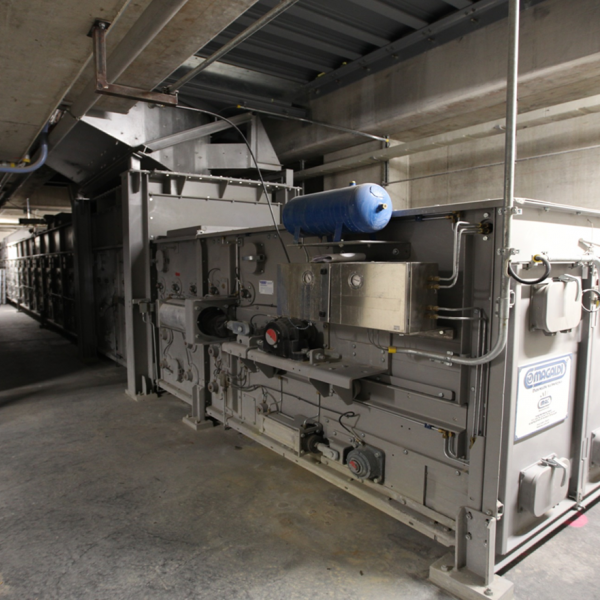Il sistema Ecobelt® WA
Brevettato per l'estrazione a secco, il raffreddamento ad aria e il trasporto meccanico di scorie/ceneri pesanti generate durante la combustione dei rifiuti solidi
Data la crescente pressione per raggiungere gli obiettivi di decarbonizzazione e adottare modelli di economia circolare, la valorizzazione delle ceneri pesanti è diventata essenziale per promuovere un cambiamento di paradigma basato sul profitto e sulla sostenibilità anziché sui costi.
L'approccio a secco nell'estrazione delle ceneri offre numerosi vantaggi economici, riducendo contemporaneamente l'impatto ambientale degli impianti di termovalorizzazione.
Riduzione del peso delle ceneri
Eliminando l'acqua, il peso delle ceneri viene ridotto di circa il 20%, riducendo i costi di trasporto e messa a discarica.
Eliminazione dell'acqua e dei relativi sistemi di trattamento
Con il sistema Ecobelt® WA, le ceneri pesanti vengono raffreddate e trasportate senza alcun utilizzo di acqua, completamente sostituita da un flusso di aria ambiente come mezzo di raffreddamento primario.
Il risultato è un'efficace mitigazione dell'impatto ambientale del processo e una riduzione dei costi di O&M poiché non è necessario smaltire o trattare l'acqua.
Riduzione del carbonio organico totale (TOC)
L'estrazione a secco consente la postcombustione delle ceneri nell'area di scarico, riducendo il contenuto di carbonio organico totale (TOC) residuo al di sotto dello 0,5%.
Inoltre, il calore residuo contenuto nelle ceneri, che altrimenti andrebbe perso nel bagno d'acqua, può essere completamente recuperato, trasferito all'aria di raffreddamento e reintrodotto in caldaia sotto forma di aria preriscaldata.
Recupero più efficiente dei metalli e
Possibile riutilizzo della frazione inerte
Poiché alle ceneri non viene aggiunta acqua, è possibile ottenere un recupero di metalli più elevato, soprattutto nelle frazioni più fini.
Recuperando più metalli, la qualità della frazione inerte è più favorevole per un ulteriore utilizzo poiché sono presenti meno metalli pesanti tossici.
La tecnologia di trasporto Superbelt®
Il sistema Ecobelt® WA utilizza il trasportatore a nastro Superbelt® che offre una serie di vantaggi competitivi importanti, tra cui:
- elevata affidabilità
- resistenza alle alte temperature
- resistenza agli urti
- usura minima
- ridotti consumi energetici
- manutenzione minima.
Alcune storie di successo
Svizzera
Conversione da umido a secco
Impianto waste-to-energy

L'estrazione secca dell'IBA (Incinerator Bottom Ash) è stata la caratteristica chiave per ottenere una separazione e recupero più efficaci di metalli e minerali dalla miscela di ceneri.
Il Cliente
L'impianto Waste-to-Energy è composto da 3 linee di combustione che bruciano rifiuti domestici e industriali. È il primo impianto al mondo di trattamento IBA completamente secco.
La Sfida
Il cliente aveva la necessità di sostituire un nastro trasportatore a nastro basato su un sistema a coclea che raccoglieva le ceneri di fondo secche dalle linee di combustione #2 e #3.
Successivamente, Magaldi ha anche eseguito la conversione da umido a secco del sistema di gestione delle ceneri di fondo sulla linea di incenerimento #1.
La Soluzione
Un nastro Ecobelt® WA trasporta le ceneri di fondo secche dalle linee #2 e #3 fino al trattamento delle ceneri secche e alla struttura di recupero dei metalli.
Installato al posto di un pistone idraulico umido e del nastro trasportatore in gomma a valle, un secondo Ecobelt® WA trasporta:
- le ceneri di fondo calde e le ceneri setacciate prodotte dalla linea #1
- le ceneri di fondo calde prodotte dalle linee #2 e #3.
Il sistema Ecobelt® WA ha permesso di superare tutti i problemi di scarsa affidabilità, interruzioni imprevedibili e onde di impulsi verso il forno, generate dai sistemi esistenti.
Italia
Gestione delle Ceneri di Fondo da Inceneritore Secche
Impianto waste-to-energy

L'Ecobelt® WA ha risolto i problemi di manutenzione e tutti i problemi di scarsa affidabilità, interruzioni imprevedibili e pericoli per la sicurezza.
Il Cliente
La centrale WtE consiste in 3 linee di combustione, progettate per convertire termicamente circa 397.000 tonnellate all'anno di combustibile solido secondario (SSF).
La Sfida
Magaldi è stata selezionata per eseguire la conversione da umido a secco del sistema di gestione delle ceneri di fondo (IBA) sulle linee di combustione gemelle #2 e #3. I nastri trasportatori a nastro sommergibile esistenti stavano causando gravi problemi:
- IBA con un elevato contenuto di umidità (>25%), aumentando così i costi di smaltimento;
- frequenti intasamenti che influivano sul normale funzionamento, causando anche pericoli per la sicurezza;
- nessuna manutenzione poteva essere eseguita con il sistema IBA umido in funzione.
La Soluzione
Ogni linea di combustione è dotata di 2 nastri trasportatori Ecobelt® WA che trasportano e raffreddano sia le ceneri di fondo che le ceneri setacciate in modo completamente secco.
A valle dei nastri Ecobelt® WA, le ceneri vengono condizionate utilizzando una piccola quantità di acqua per ridurre la polvere e consentire il trasporto sicuro fino all'impianto di recupero dei metalli.
Giappone
Conversione da umido a secco
Impianto waste-to-energy

Il sistema Ecobelt® WA si è dimostrato il migliore sul mercato in termini di costi operativi e protezione ambientale.
Il Cliente
L'impianto è composto da 2 linee di combustione, ciascuna in grado di bruciare fino a 350 tonnellate/giorno di rifiuti solidi urbani. La potenza complessiva prodotta è di 15 MWe.
La Sfida
Il cliente aveva l'obiettivo di sostituire i vecchi nastri trasportatori a catena sommergibile umidi con una tecnologia più affidabile, ecologica e facile da mantenere.
La Soluzione
I nastri Ecobelt® WA hanno offerto vantaggi sia tecnici che economici per il raffreddamento e la gestione delle ceneri di fondo (IBA). I sistemi di gestione delle ceneri di fondo secche non richiedono acqua né per il raffreddamento né per il trasporto, portando quindi a risparmi idrici e all'eliminazione completa dei costi associati al trattamento delle acque reflue. Inoltre, i metalli ferrosi vengono recuperati in modo più efficiente dalle ceneri di fondo secche.













